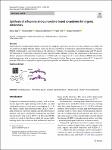Item Infomation
Full metadata record
| DC Field | Value | Language |
|---|---|---|
| dc.contributor.author | Marco, Sigl | - |
| dc.contributor.author | Thomas, Rath | - |
| dc.contributor.author | Bettina, Schlemmer | - |
| dc.date.accessioned | 2023-04-20T03:00:57Z | - |
| dc.date.available | 2023-04-20T03:00:57Z | - |
| dc.date.issued | 2023 | - |
| dc.identifier.uri | https://link.springer.com/article/10.1007/s00706-022-03030-7 | - |
| dc.identifier.uri | https://dlib.phenikaa-uni.edu.vn/handle/PNK/8121 | - |
| dc.description | CC BY | vi |
| dc.description.abstract | Quinoxaline has recently gained interest as monomer in conjugated copolymers because of its easy synthetic accessibility and successful use in highly efficient organic solar cells. In this contribution, we introduce a quinoxaline–fluorene-co-polymer, PFQ10, synthesized by copolymerization of 5,8-dibromo-6,7-difluoro-2-[(2-hexyldecyl)oxy]quinoxaline and 9,9-dioctyl-9H-9-fluorene-2,7-bis(boronic acid pinacol ester) using the Suzuki–Miyaura reaction. By optimization of the reaction conditions, polymers with molecular weights up to 17.2 kDa and a low dispersity of 1.3 were obtained. PFQ10 showed blue photoluminescence with an emission maximum at 459 nm and a relative fluorescence quantum yield of 0.37. As proof of principle, PFQ10 was employed in organic light-emitting diodes and showed a blue–green electroluminescence. | vi |
| dc.language.iso | en | vi |
| dc.publisher | Springer | vi |
| dc.subject | PFQ10 | vi |
| dc.title | Synthesis of a fluorene and quinoxaline-based co-polymer for organic electronics | vi |
| dc.type | Book | vi |
| Appears in Collections | ||
| OER - Khoa học Tự nhiên | ||
Files in This Item:

